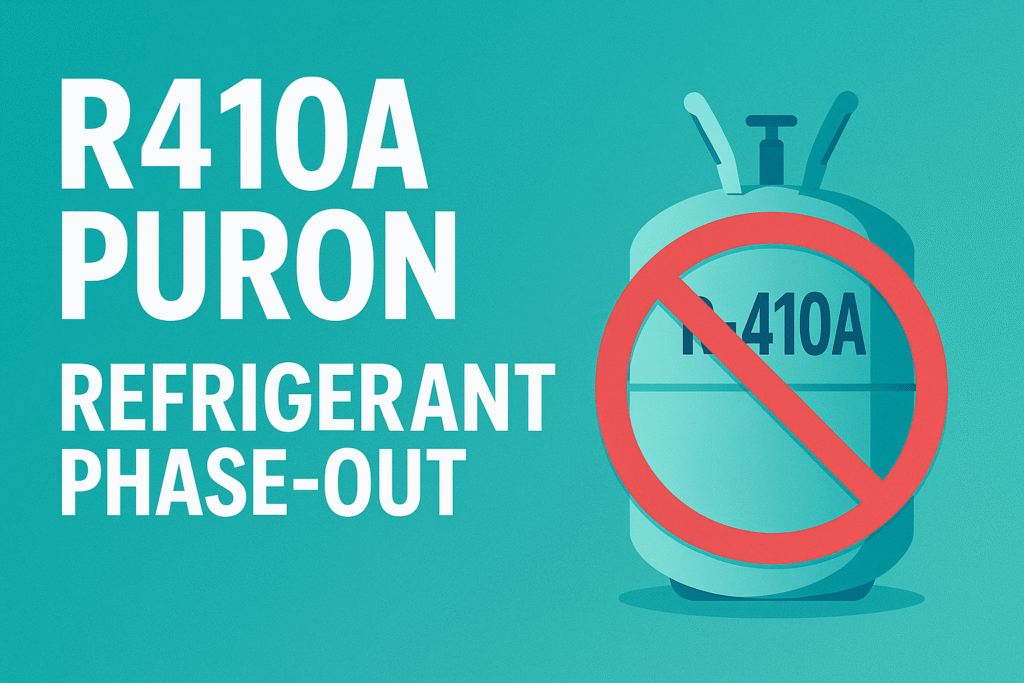R410a Puron Refrigerant Phase Out is underway as part of global efforts to reduce environmental impact and meet new regulatory standards. This phase-out affects HVAC systems worldwide, requiring homeowners and professionals to stay informed about the timeline, reasons behind the transition, and available alternatives.
The HVAC industry is undergoing a major transformation as environmental regulations push for greener, more sustainable technologies. At the center of this change is the phase-out of R410a refrigerant—commonly known as Puron. This widely used refrigerant once considered a cleaner alternative to R22, is now being phased out due to its high global warming potential (GWP).
Whether you’re a homeowner, business owner, or HVAC professional, understanding why this transition is happening, what it means for your current systems, and how to prepare is crucial. This guide explores the reasons behind the phase-out, the timeline, and the best steps you can take moving forward.
What is R410a and Why Was It Popular?
R410a is a hydrofluorocarbon (HFC) refrigerant that became the standard for residential and commercial air conditioning systems in the early 2000s. It was introduced as a replacement for R22, a hydrochlorofluorocarbon (HCFC) that was found to be harmful to the ozone layer.
Unlike R22, R410a does not contribute to ozone depletion, making it a more environmentally friendly option at the time of its adoption. It also operates at higher pressures, which generally results in better energy efficiency and improved cooling performance. As such, HVAC manufacturers around the world quickly adopted R410a as the new standard in compliance with international environmental regulations like the Montreal Protocol.
However, despite its ozone-friendly profile, R410a has one significant drawback: its global warming potential is extremely high. This is now the driving force behind its global phase-out.
Why Is the R410a Puron Refrigerant Being Phased Out?
The primary reason for phasing out R410a is its contribution to climate change. While R410a doesn’t harm the ozone layer, it has a GWP of 2,088. This means that one unit of R410a is over 2,000 times more potent than carbon dioxide when it comes to trapping heat in the atmosphere.
As nations intensify efforts to combat global warming, attention has shifted from ozone depletion to greenhouse gas emissions. The Kigali Amendment to the Montreal Protocol, enacted in 2019, mandates a gradual reduction in the production and consumption of HFCs like R410a. These global efforts aim to significantly cut the use of high-GWP refrigerants in favor of more sustainable alternatives.
Many countries have committed to this timeline, planning for an 85% reduction in HFC usage by 2036. As a result, manufacturers, service providers, and consumers alike are being urged to prepare for a new era in refrigerant technology.
R410a Phase-Out Timeline: What to Expect
The phase-out of R410a is not immediate; instead, it’s being implemented gradually to allow the HVAC industry time to adjust. Here’s a general breakdown of the expected timeline:
- 2023 to 2025: A gradual reduction in the production and import of R410a refrigerant. Manufacturers are encouraged to begin shifting toward alternative refrigerants with lower GWP.
- By 2025: R410a will no longer be permitted in newly manufactured residential and light commercial air conditioning and heat pump systems in many regions.
- 2030 to 2036: A full phase-out of R410a in new systems is expected. However, existing systems can continue operating and receiving maintenance as long as R410a is available.
How This Affects the Market
- For Manufacturers: HVAC manufacturers are investing heavily in R&D to develop systems compatible with newer, lower-GWP refrigerants. This requires re-engineering existing technologies and ensuring the safety and performance of new refrigerant blends.
- For Homeowners and Businesses: Consumers will begin to notice fewer R410a-based systems available for purchase. Servicing older units may become more expensive over time as the supply of R410a declines and its price increases.
Alternatives to R410a Puron Refrigerant Phase Out
With R410a on its way out, several alternative refrigerants are gaining traction. Each offers specific benefits and considerations, depending on application needs.
R32
R32 is one of the most popular substitutes for R410a. It has a GWP of 675—about 70% lower than R410a—and is already being used in many newer air conditioning systems worldwide. R32 offers similar or even better efficiency than R410a. However, it is classified as mildly flammable (A2L), which means technicians must follow specific handling protocols.
R454B
R454B is another promising alternative with a very low GWP of 466. It’s designed to closely mimic the performance of R410a, making it easier to transition systems with minimal modifications. Like R32, it is mildly flammable and requires extra care during installation and servicing.
R466A
This refrigerant has a GWP of around 733 and is notable for being non-flammable. While it has not been as widely adopted as R32 or R454B, it offers a safer option for settings where flammability is a concern.
Natural Refrigerants
Natural options like carbon dioxide (R744) and propane (R290) are also gaining popularity. These refrigerants have extremely low GWPs—near zero—but come with unique challenges. CO₂ systems require high-pressure components, while propane systems need strict safety measures due to flammability. These are typically used in specialized or commercial applications.
What Should Homeowners and Businesses Do?
The phase-out of R410a doesn’t mean you need to panic or rush to replace your HVAC system. However, a proactive approach will help you avoid costly surprises and keep your system running efficiently for as long as possible.
Maintain Your Current System
- Regular Inspections: Schedule routine maintenance with a qualified technician to check for leaks and ensure your system is operating at peak efficiency.
- Leak Detection: Because of R410a’s high GWP, even small leaks can be harmful to the environment and reduce your system’s performance.
- Use Certified Technicians: Ensure your HVAC professional is trained to work with both R410a and the emerging alternatives.
Plan for Future Replacement
- Evaluate System Age: If your current system is more than 10-15 years old, it may be more economical to start planning for a new unit that uses a low-GWP refrigerant.
- Upgrade to Energy-Efficient Models: Modern HVAC systems with alternative refrigerants often come with improved efficiency, which can help reduce your energy bills and carbon footprint.
- Look for Compliant Units: Select systems that are compliant with current and upcoming environmental regulations to ensure long-term savings and sustainability.
Consider Long-Term Maintenance Plans
- Seasonal Tune-Ups: Preventative maintenance before each cooling or heating season can help extend system life and identify potential problems early.
- Service Agreements: Enroll in a maintenance contract to receive priority service, regular inspections, and discounts on necessary repairs.
Final Thoughts
The phase-out of R410a refrigerant marks a significant milestone in the HVAC industry’s transition toward sustainability. While this change may seem challenging at first, it ultimately supports a cleaner, greener environment by reducing harmful greenhouse gas emissions.
As the availability of R410a decreases, shifting to low-GWP refrigerants will become not just a regulatory requirement but a smart investment in the future of your comfort and energy efficiency. The key is to stay informed, maintain your current system responsibly, and plan strategically for upgrades when the time is right.
By taking action today—whether through maintenance, expert consultations, or planning for a system replacement—you can stay ahead of the curve, protect your property, and contribute to a more sustainable future.


